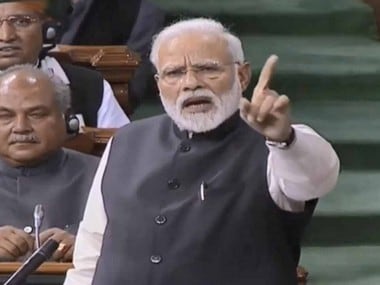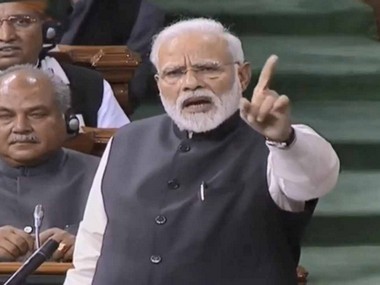When an orator speaks, he sets the terms of the debate. This is a practice as old as human communication, perhaps, but its importance especially in public speaking can never be overstated. We witnessed this on Thursday all over again when Prime Minister Narendra Modi rose up to deliver the motion of thanks to the president’s address in the Lok Sabha: ostensibly his last speech on the floor of the House in this tenure as prime minister. What exactly does ‘setting the terms of debate’ signify? We see party spokespersons — all of whom are not necessarily orators or even good communicators — try this tactic all the time during TV debates. Instead of answering the question pointed at them, they shift the goalposts and deliver their prepared party line. Often, the debates become meaningless. What the prime minister did on Thursday was something quite different, and possible only for someone who knows the art of communication. [caption id=“attachment_6048291” align=“alignleft” width=“380”]  Narendra Modi addressing the Parliament on Thursday. Twitter@BJP4India[/caption] Modi took each criticism against his government and his style of functioning and presented a point-by-point rebuttal. He took recourse to numbers and data while making his case instead of relying on rhetoric alone. Whether his claims were accurate or not will become evident as the speech is analysed and parsed. But his more important achievement, arguably, was to set the frames of reference for future debates while staying within these parameters — not breaking them — and creating some catchy slogans for the BJP to capitalise on. Therefore, instead of being just an account of his work, response to criticism and reaching out to voters ahead of elections (the speech was all of this), the address achieved significance as a reference point for campaigns, rallies, commentaries and media discussions in what is going to be India’s most bitterly contested elections. But why is this important? To understand this, let us take a look at the what the Congress has been trying to do on the issue of Rafale. As has been mentioned in these columns before, Congress chief Rahul Gandhi has launched a virulent attack against the government on the fighter jets because his team of in-house data analysts have identified this complex deal and the controversy around it as a “sticking point” in campaigns. The government has tried to rebut Rahul’s charges with facts and by citing the Supreme Court verdict, but its efforts have not been enough to counter Congress’s charge that “Modi has put Rs 30,000 crore in Anil Ambani’s pocket”. It is difficult to understand the basis of Rahul’s charge or the figure cited by him: going by publicly available information. Either the Congress president is privy to information which even the Supreme Court is unaware of, or he has been economical with truth. Rahul has so far failed to furnish any proof behind his allegations. But he has nevertheless succeeded in creating a narrative that the government has something to “hide” on the Rafale deal. What Modi, therefore, did on Thursday was to turn Congress’ allegations on its head and bring two counter charges against the party: both of which are grave. He began by citing that Defence Minister Nirmala Sitharaman has rebutted each and every charge of the Congress, cited Supreme Court’s order which exonerated the government from any wrongdoing and even rebuked the petitioners for bringing some frivolous charges, and then accused the Congress of trying to weaken the armed forces by purposely denying them a next generation fighter, perhaps at the behest of Rafale’s competitors. “I am levelling a serious allegation,” Modi said. “I want to say it on the floor of Parliament that the Indian National Congress doesn’t want our armed forces to be strong. They don’t want our security apparatus to be strong. Which companies are they (Congress) bidding for that they are acting so shamefully.” Modi’s counter brought the focus of attention on Congress’s motives behind opposing the deal but by Friday morning, the narrative had changed again owing to a report carried by The Hindu that cited a defence ministry note in 2015 to report that at the height of Rafale negotiations, “the defence ministry raised strong objections to ‘parallel negotiations’ conducted by the Prime Minister’s Office (PMO).” The Congress latched on to it and Rahul — who was battling charges in the morning on whether Congress was “weakening Air Force” at the behest of foreign competitors of Rafale — against repeated his allegation that the PM “is a thief” and he has favoured Anil Ambani.
Rahul Gandhi on PM Modi's allegation that Congress is weakening the Indian Air Force: Modi Ji has stolen Rs 30, 000 crore, Defence Ministry has clearly said in a report that PM was carrying out parallel negotiations, the truth has come out. pic.twitter.com/G6wcRONroT
— ANI (@ANI) February 8, 2019
Incidentally, the defence ministry note in question was prepared by G Mohan Kumar, then defence secretary at the time of Rafale negotiations. He told news agency ANI that his note “had nothing to do with price negotiations but sovereign guarantee and general terms and conditions.”
It (MoD dissent note on #Rafale negotiations) had nothing to do with price. It was about sovereign guarantees and general terms and conditions: G Mohan Kumar, Defence Secretary at the time of Rafale negotiations to ANI pic.twitter.com/BFaGqOvnQg
— ANI (@ANI) February 8, 2019
Whatever has been brought out ( recent media report on #Rafale by the Hindu) has nothing to do with pricing: G Mohan Kumar,Defence Secretary at the time of Rafale negotiations to ANI https://t.co/iZtVlF3Cqb
— ANI (@ANI) February 8, 2019
The former defence secretary’s clarification effectively nullifies Rahul’s fresh charges, but that hasn’t stopped the Congress from renewing allegations that the Supreme Court judgment carries no meaning because the apex court was “misled” by the government. MoD will doubtless respond to the fresh allegations, but the controversy is not going to die down any time soon. Apart from Rafale — where PM’s counter was somewhat marred by late developments — Modi also coined a new term “mahamilavati” to describe the “mahagathbandhan”. The term, that loosely translates into an impure concoction, takes a dig at the inherent contradictions of the grand alliance. The trick of the coinage, however, lies in its simplicity that may appeal to the electorate during rallies. It also sets the ‘grand alliance’ in pejorative terms to automatically suggest that anything impure can’t be good for the body: in this case, the country. The PM also came armed with statistics on jobs and tried to refute the narrative that jobs were not being created. He mixed anecdotal with statistical references to point out that an economy on the move cannot do so unless jobs were being created. So the problem lay, according to Modi, not in the fact that there are no jobs, but rather there is no authentic way in recording the jobs 90 percent of which are being created in the informal sector. Modi gave a number of references from developments in transport sector to rise in number of non-corporate tax payers such as CA and doctors who employ a number of people. Modi’s biggest intervention, however, was in terms of giving an account of his government’s work in 55 months. He framed it within a comparison of 55 months of Modi Sarkar to Congress’ rule over India since Independence and referred to different sectors such as housing, optical fiber network, electrification, cleanliness drive, gas connection, inflation, steps against corruption and pointed out that his government has achieved more in 55 months than Congress achieved in 55 years. The larger point, of course, is a plea to the voters that only a strong government that doesn’t lend itself to pulls and pressures from coalition partners can take India ahead. Modi’s calling card was a comparison between 55 years of “sattabhog” by Congress compared to 55 months of “sewabhav” of his government that works on the basis of spash niti (clear policies), saaf niwat (clear conscience), nek irade (good intention) and atal nistha (steadfast dedication). Whether or not that message goes through, of course, remains to be seen.


)
)
)
)
)
)
)
)
)



